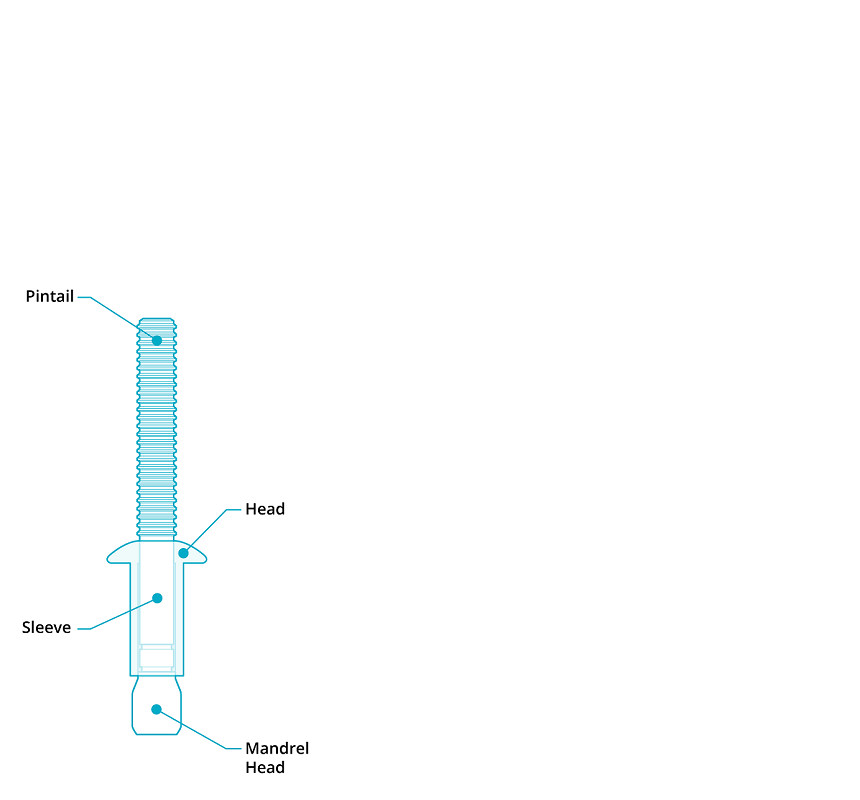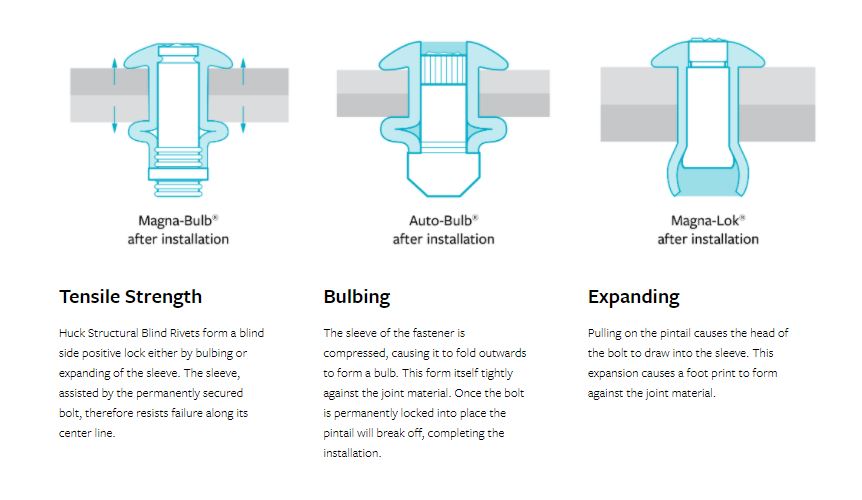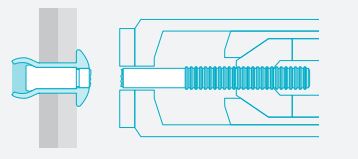A structural blind rivet is a one-piece fastener made from two assembled components; a pin, and a sleeve which delivers a permanent, vibration-resistant joint in which the pin is retained post-installation for greater strength. Unlike a lockbolt or standard nut and bolt, they can be installed with access to only one side of the material.
Each Huck structural blind fastener is engineered with a unique set of features that deliver industry-leading solutions to common manufacturing challenges, from high-speed assembly, hole-filling, and water-resistance to needs for a wide grip, for welding replacement, and applications with one-sided access.
Installation is similar for each fastener type using our extensive line of Huck tooling and nose assemblies.
Huck structural blind fasteners insert through aligned holes of the materials being joined. The tool nose assembly grips the pintail, pulls the mandrel head towards the sleeve, causing the sleeve to expand or bulb on the blind side of the hole. This pulls the materials together, locks the mandrel and sleeve, and breaks the pintail flush with rivet head, all within a couple of seconds.
- Joins Materials With One-Side Access
- Excellent Gap Pull-Out and High Retained Clamp
- Industry-Leading Shear, Tensile, Pull-Out Strength
Huck Blind Fasteners
A structural blind rivet is a one-piece fastener made from two assembled components; a pin, and a sleeve which delivers a permanent, vibration-resistant joint in which the pin is retained post-installation for greater strength. Unlike a lockbolt or standard nut and bolt, they can be installed with access to only one side of the material.
Each Huck structural blind fastener is engineered with a unique set of features that deliver industry-leading solutions to common manufacturing challenges, from high-speed assembly, hole-filling, and water-resistance to needs for a wide grip, for welding replacement, and applications with one-sided access.
Installation is similar for each fastener type using our extensive line of Huck tooling and nose assemblies.
Huck structural blind fasteners insert through aligned holes of the materials being joined. The tool nose assembly grips the pintail, pulls the mandrel head towards the sleeve, causing the sleeve to expand or bulb on the blind side of the hole. This pulls the materials together, locks the mandrel and sleeve, and breaks the pintail flush with rivet head, all within a couple of seconds.
- Joins Materials With One-Side Access
- Excellent Gap Pull-Out and High Retained Clamp
- Industry-Leading Shear, Tensile, Pull-Out Strength

INSTALLATION ANIMATION:
HOW DO BLIND FASTENERS WORK?
The shear strength of structural blind fasteners is generated by the combined resistance against failure of the pin and sleeve. This takes place along the joint shear line between fastened plates.The shear strength of structural blind fasteners is generated by the combined resistance against failure of the pin and sleeve. This takes place along the joint shear line between fastened plates.
The tensile strength of structural blind fasteners differs to that of LockBolts, as they form a blind side positive lock either by bulbing or expanding of the sleeve. The sleeve, assisted by the permanently secured pin, therefore resists failure along its centre line.
1. Bulbing
The sleeve of the fastener is compressed, causing it to fold outwards to form a bulb. This forms itself tightly against the joint material. Once the pin is permanently locked into place the pintail will break off, completing the installation.
2. Expanding
Pulling on the pintail causes the head of the pin to draw into the sleeve. This expansion causes a foot print to form against the joint material.
Note: The pre-load of blind rivets is generally not published, as it varies widely depending on the application.
Installation Sequence
-
1. Pin placed into prepared hole, tools is placed over the fastener pintail
-
2. Tool activated, deforming of blind side begins
-
3. Joint tightened, internal locking mechanism formed
-
4. Pintail breaks, installation complete
Blind Fastener Benefits
-
HIGH PERFORMANCE MAINTENANCE FREE JOINTS
-
QUICK & CONSISTENT INSTALLATION
-
GREATER FLEXIBILITY IN YOUR PRODUCTION
-
LOWER OVERALL COST
Get in Touch
Our team of experts will be glad to answer your questions.








